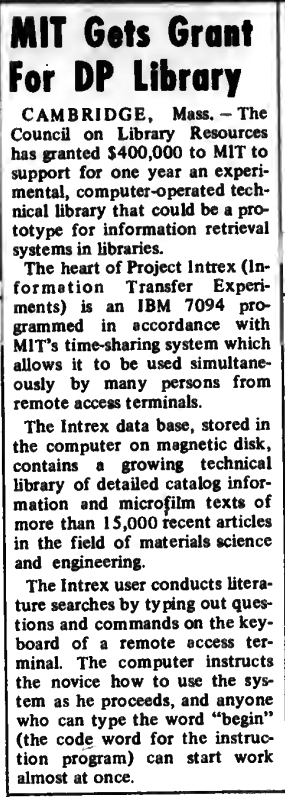Feb. 2, 1972: MIT’s Project INTREX introduces computers to the library
A series of experiments in computerized information retrieval transformed one of MIT’s libraries.

In 1972, a $400,000 grant was awarded to MIT for Project INTREX, a series of ambitious “information transfer experiments” within the MIT library system that aimed to use computers to streamline information retrieval. Project INTREX didn’t revolutionize the library system on its own – it would take several more decades of library experiments and technological advancements to achieve the fast, information-rich systems we have today. Nevertheless, the project generated important advancements both for integrating libraries with computers and developing interactive multi-user systems.
According to an article in Computerworld magazine, Project INTREX featured an augmented catalog of available texts along with thousands of full article texts stored on microfilm. Back in the days of Project INTREX, computers were limited to running very few programs at a time and were too expensive for each faculty member or student to have access to their own computer. In the late 1960s, “time-sharing” systems became a popular solution, giving multiple users access to a central computer. Each user’s program would run for an allotted period of time before the system paused it and moved on to the next program. Project INTREX implemented a multi-user system by combining a time sharing system with an IBM 7094 computer and remote-access terminals where users could input their commands. From their remote terminals, users could browse the catalog data, which was stored on the central IBM computer. They could also view images of the articles stored on microfilm, although the technological limitations of the time prevented this feature from becoming fully multi-user.
Project INTREX was unique from other library experiments at the time because it was run by engineers and focused on addressing the needs of the engineering community within the library system. The interdisciplinary nature of the project left a large impact on INTREX intern Susan Nutter, who would later become the director of the North Carolina State University Libraries. During her 30 years at NCSU, she led the development of the Hunt Library, which won several awards for its innovative technological integrations.
–By Kathleen Esfahany